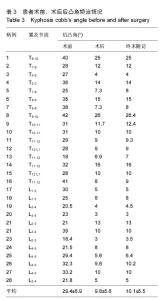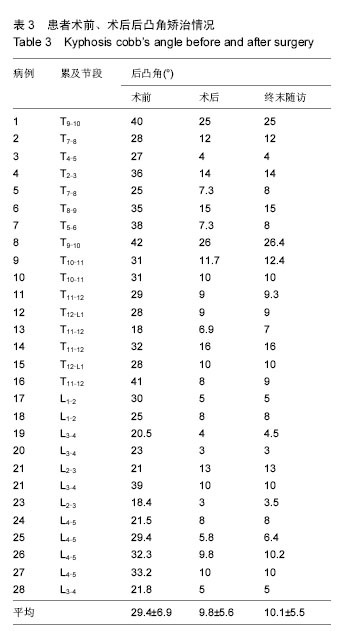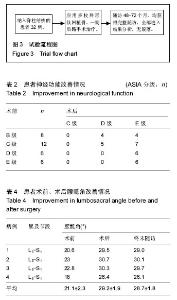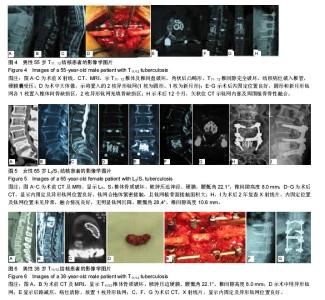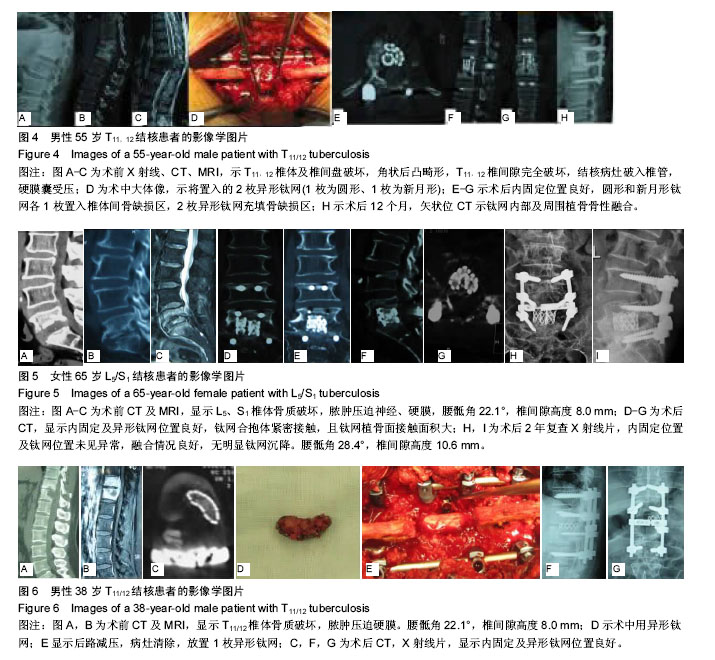Chinese Journal of Tissue Engineering Research ›› 2016, Vol. 20 ›› Issue (48): 7192-7199.doi: 10.3969/j.issn.2095-4344.2016.48.007
Previous Articles Next Articles
Special formed titanium mesh cages for treating spinal tuberculosis via one-stage posterior approach
Abudunaibi•Aili1, 2, Zhang Hong-qi1, Huang Wei-min2, Li Lei2, Tian Hui-zhong2
- 1Spinal Surgery Center, Xiangya Hospital, Central South University, Changsha 410000, Hunan Province, China; 2Second Department of Spinal Surgery, Sixth Affiliated Hospital, Xinjiang Medical University, Urumqi 830000, Xinjiang Uygur Autonomous Region, China
-
Revised:2016-09-02Online:2016-11-25Published:2016-11-25 -
Contact:Zhang Hong-qi, M.D., Chief physician, Spinal Surgery Center, Xiangya Hospital, Central South University, Changsha 410000, Hunan Province, China -
About author:Abudunaibi?Aili, Studying for doctorate, Attending physician, Spinal Surgery Center, Xiangya Hospital, Central South University, Changsha 410000, Hunan Province, China; Second Department of Spinal Surgery, Sixth Affiliated Hospital, Xinjiang Medical University, Urumqi 830000, Xinjiang Uygur Autonomous Region, China -
Supported by:the General Program of the Natural Science Foundation of Xinjiang Uygur Autonomous Region, No. 2016D01C219
CLC Number:
Cite this article
Abudunaibi•Aili, Zhang Hong-qi, Huang Wei-min, Li Lei, Tian Hui-zhong. Special formed titanium mesh cages for treating spinal tuberculosis via one-stage posterior approach[J]. Chinese Journal of Tissue Engineering Research, 2016, 20(48): 7192-7199.
share this article
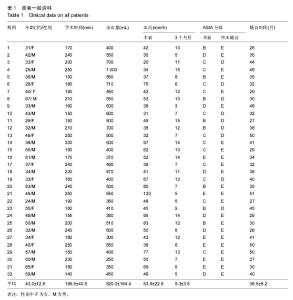
2.1 参与者数量分析 按意向性处理,纳入符合条件的脊柱结核患者32例,无脱落,均得到完整的随访结果。试验流程图见图3。 2.2 一般情况 手术时间为140-300 min,平均(199.5±40.5) min;术中失血量250-1 000 mL,平均(520.0±164.4) mL。术后随访48-72个月。术后3个月所有患者血沉恢复至正常水平(表1)。 2.3 神经功能及影像学评价结果 术前合并神经功能障碍的患者术后神经功能均有不同程度的恢复。4例由ASIA分级B级改善为D级,4例由B级改善为E级,5例由C级改善为D级,7例由C级改善为E级,6例由D级改善为E级。最后随访时,ASIA分级D级9例,E级23例(表2)。所有患者术后局部疼痛症状有所缓解,术后2周患者目测类比评分由术前平均(6.8±1.2)分改善至(2.2±0.8)分,差异有显著性意义(P=0.000)。 术后腰骶角、胸腰椎后凸角和椎间隙高度与术前相比明显好转(表3,4),差异有显著性意义(P < 0.001),末次随访时与术后比较差异无显著性意义(P > 0.05)。 32例患者均获得完全骨性融合,融合时间平均7个月。32例患者脊柱结核均获得临床治愈。"
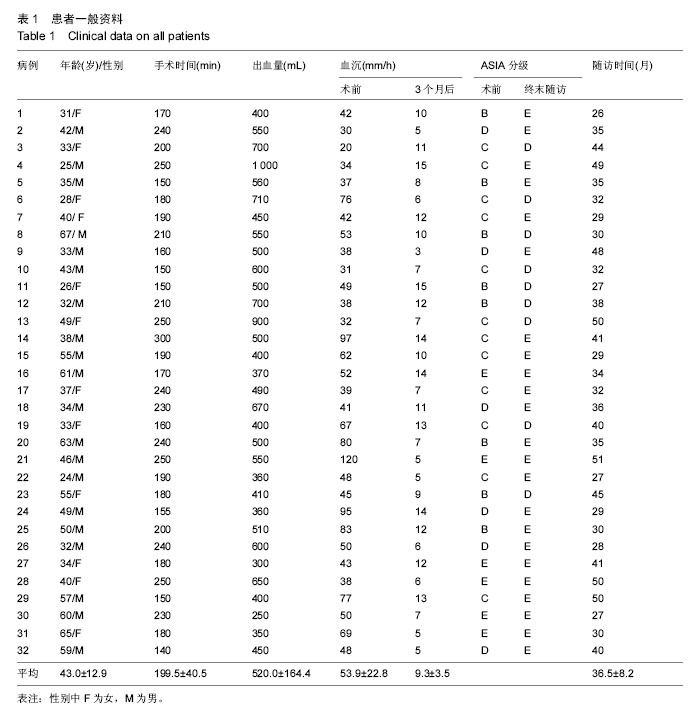
| [1] 甘炳武.手术配合中药治疗脊柱结核临床效果探讨[J].当代医学,2013,12(18):146-147.[2] Issack PS, Boachie-Adjei O. Surgical correction of kyphotic deformity in spinal tuberculosis. Int Orthop. 2012;36(2):353-357.[3] Zhang HQ, Lin MZ, Ge L, et al. Surgical management by one-stage posterior transforaminal lumbar debridement, interbody fusion, and posterior instrumentation for lumbo-sacral tuberculosis in the aged. Arch Orthop Trauma Surg. 2012;132(12): 1677-1683.[4] Ma YZ, Cui X, Li HW, et al. Outcomes of anterior and posterior instrumentation under different surgical procedures for treating thoracic and lumbar spinal tuberculosis in adults. Int Orthop. 2012;6 (2):299-305.[5] Liu Y, Chen Y, Yang L, et al. The surgical treatment and related management for post-tubercular kyphotic deformity of the cervical spine or the cervico-thoracic spine. Int Orthop. 2012;36 (2):367-372.[6] Zhang HQ, Lin MZ, Ge L, et al. Surgical management by one-stage posterior transforaminal lumbar debridement, interbody fusion, and posterior instrumentation for lumbo-sacral tuberculosis in the aged. Arch Orthop Trauma Surg. 2012;132(12): 1677-1683.[7] Zhang HQ, Lin MZ, Shen KY, et al. Surgical management for multilevel noncontiguous thoracic spinal tuberculosis by single-stage posterior transforaminal thoracic debridement, limited decompression, interbody fusion, and posterior instrumentation (modified TTIF). Arch Orthop Trauma Surg. 2012;132(6): 751-757.[8] Zhang HQ, Lin MZ, Li JS, et al. One-stage posterior debridement, transforaminal lumbar interbody fusion and instrumentation in treatment of lumbar spinal tuberculosis: a retrospective case series. Arch Orthop Trauma Surg. 2013;133(3): 333-341.[9] 张宏其,郭虎兵,陈筱,等.单纯一期后路病灶清除椎体间植骨融合内固定治疗胸椎结核的临床研究[J].中国矫形外科杂志,2012,20(1):34-40.[10] 武士科,高文山,步宏建,等.有限病灶清除联合局部化疗治疗脊柱结核的效果观察[J].山东医药,2014,54(12): 59-61.[11] 刘鹏,姜晖,翟东滨,等.胸椎和腰椎脊柱结核手术入路术式选择研究[J].中国医科大学学报,2013,42(3):253-256.[12] Soh J, Lee JC, Shin BJ, et al. Analysis of risk factors for adjacent segment degeneration occurring more than 5 years after fusion with pedicle screw fixation for degenerative lumbar spine. Asian Spine J. 2013;7(4): 273-281.[13] Kim HJ, Kang KT, Chang BS, et al. Biomechanical analysis of fusion segment rigidity upon stress at both the fusion and adjacent segments: acomparison between unilateral and bilateral pedicle screw fixation. Yonsei Med J. 2014;55(5):1386?1394.[14] Moon MS. Tuberculosis of spine: current views in diagnosis and management.Asian Spine J. 2014;8(1): 97-111.[15] Jiang H, Xiao ZM, Zhan XL, et al. Anterior transsternal approach for treatment of upper thoracic vertebral tuberculosis. Orthop Surg. 2010;2(4): 305-309.[16] Sundararaj GD, Amritanand R, Venkatesh K. The Use of Titanium Mesh Cages in the Reconstruction of Anterior Column Defects in Active Spinal Infections: Can We Rest the Crest? Asian Spine J. 2011;5: 155-161.[17] Kumar MN, Joseph B, Manur R, et al. Isolated posterior instrumentation for selected cases of thoraco-lumbar spinal tuberculosis with out anterior instrumentation and without anterior or posterior bone grafting. Eur Spine J. 2013; 22(3): 624-632.[18] Garg B, Kandwal P, Nagaraja UB, et al. Anterior versus posterior procedure for surgical treatment of thoraco-lumbar tuberculosis: A retrospective analysis. Indian J Orthop. 2012;46(2):165-170.[19] Pola E, Rossi B, Nasto LA, et al. Surgical treatment of tuberculous spondylodiscitis. Eur Rev Med Pharmacol Sci. 2012;16 (2):79-85.[20] He Q, Xu J. Comparison between the antero-posterior and anterior approaches for treating L5-S1 vertebral tuberculosis. Int Orthop. 2012;36(2):345-351.[21] 李熙雷,车武,董建,等.经伤椎单节段椎弓根螺钉固定治疗胸腰椎爆裂骨折的生物力学研究[J].中华创伤骨科杂志,2012, 14(3):225-227.[22] Zhang H,Zeng K,Yin X,et al. Debridement, internal fixation, and reconstruction using titanium mesh for the surgical treatment of thoracic and lumbar spinal tuberculosis via a posterior-only approach: a 4-year follow-up of 28 patients. J Orthop Surg Res. 2015; 10(1):150.[23] Virk SS, Niedermeier S, Yu E, et al. Adjacent segment disease. Orthopedics. 2014;37(8): 547-555. [24] 张宏其,郭超峰,唐明星,等.一期后路病灶清除、异形钛网椎间植骨融合治疗胸、腰椎结核[J].中华骨科杂志, 2014,34(2): 102-109.[25] Ekinci S, Akyildiz F, Ersen O, et al. A retrospective controlled study of three different operative approaches for the treatment of thoracic and lumbar spinal tuberculosis. Clin Neurol Neurosurg. 2015; 136:51.[26] 金卫东,王骞,王自立,等.彻底与非彻底病灶清除术治疗脊柱 结核的比较[J]. 中华骨科杂志,2014,34(2): 196-205.[27] Litrico S, Lonjon N, Riouallon G, et al. Adjacent segment disease after anterior cervical interbody fusion: a multicenter retrospective study of 288 patients with long term follow up. Orthop Traumatol Surg Res. 2014;100(6 Suppl):305-309.[28] Do Brito S, Tirado A, Fernandes P. Surgical treatment of spinal tuberculosis complicated with extensive abscess. Lowa Orthop J. 2014;12(34): 129-136.[29] Cheng Z,Wang J,Zheng Q,et al. Anterolateral radical debridement and interbody bone grafting combined with transpedicle fixation in the treatment of thoracolumbar spinal tuberculosis.Medicine (Baltimore). 2015;94(14): e721. [30] Xu Z,Wang X,Shen X,et al.Two one-stage posterior approaches for treating thoracic and lumbar spinal tuberculosis :A retrospective case-control study. Exp Ther Med. 2015;9(6):2269-2274.[31] Mahir L, Meftah S, Zahi S, et al. Functional results after rehabilitation of tuberculosis myositis. Experience of PMR unit of CHU Ibn Rochd, Casablanca. Ann Phys Rehabil Med. 2016;59S: e130. [32] Madhok R, Sachdeva P.Evaluation of Apparent Diffusion Coefficient Values in Spinal Tuberculosis by MRI. J Clin Diagn Res. 2016;10(8):TC19-23. [33] Liu JM, Chen XY, Zhou Y, et al. Is nonstructural bone graft useful in surgical treatment of lumbar spinal tuberculosis?: A retrospective case-control study. Medicine (Baltimore). 2016;95(35):e4677.[34] Wang H, Yang X, Shi Y, et al. Early predictive factors for lower-extremity motor or sensory deficits and surgical results of patients with spinal tuberculosis: A retrospective study of 329 patients. Medicine (Baltimore). 2016;95(34):e4523.[35] Ying XZ, Zheng Q, Shi SY, et al. [Anterior small-incision focus debridement with posterior internal fixation for the treatment of lumbarspinal tuberculosis]. Zhongguo Gu Shang. 2016;29(6): 517-521.[36] Zou Y, Huang J. Outcomes of radical debridement versus no debridement for the treatment of thoracic and lumbar spinal tuberculosis. Int Orthop. 2016; 40(10):2089. |
| [1] | Yuan Wei, Zhao Hui, Ding Zhe-ru, Wu Yu-li, Wu Hai-shan, Qian Qi-rong. Association between psychological resilience and acute mental disorders after total knee arthroplasty [J]. Chinese Journal of Tissue Engineering Research, 2017, 21(7): 1015-1019. |
| [2] | Chen Qun-qun, Qiao Rong-qin, Duan Rui-qi, Hu Nian-hong, Li Zhao, Shao Min. Acu-Loc®2 volar distal radius bone plate system for repairing type C fracture of distal radius [J]. Chinese Journal of Tissue Engineering Research, 2017, 21(7): 1025-1030. |
| [3] | Huang Xiang-wang, Liu Hong-zhe. A new low elastic modulus of beta titanium alloy Ti2448 spinal pedicle screw fixation affects thoracic stability: biomechanical analysis [J]. Chinese Journal of Tissue Engineering Research, 2017, 21(7): 1031-1035. |
| [4] | Xie Qiang. Three-dimensional finite element model for biomechanical analysis of stress in knee inversion and external rotation after posterior cruciate ligament rupture [J]. Chinese Journal of Tissue Engineering Research, 2017, 21(7): 1036-1040. |
| [5] | He Ze-dong, Zhao Jing, Chen Liang-yu, Li Ke, Weng Jie. Multilevel finite element analysis on the biological tribology damage of water on bone tissue [J]. Chinese Journal of Tissue Engineering Research, 2017, 21(7): 1041-1045. |
| [6] | Jiang Zi-wei, Huang Feng, Cheng Si-yuan, Zheng Xiao-hui, Sun Shi-dong, Zhao Jing-tao, Cong Hai-chen,Sun Han-qiao, Dong Hang. Design and finite element analysis of digital splint [J]. Chinese Journal of Tissue Engineering Research, 2017, 21(7): 1052-1056. |
| [7] | Wang Fei, Liu Zhi-bin, Tao Hui-ren, Zhang Jian-hua, Li Chang-hong, Cao Qiang, Zheng Jun, Liu Yan-xiong, Qu Xiao-peng. Clinical efficacy of preoperative osteotomy designs using paper-cut technology versus photoshop software for ankylosing spondylitis with kyphosis [J]. Chinese Journal of Tissue Engineering Research, 2017, 21(7): 1057-1063. |
| [8] | Li Hui, Ma Jun-yi, Ma Yuan, Zhu Xu . Establishment of a three-dimensional finite element model of ankylosing spondylitis kyphosis [J]. Chinese Journal of Tissue Engineering Research, 2017, 21(7): 1069-1073. |
| [9] | Ling Guan-han, Ou Zhi-xue, Yao Lan, Wen Li-chun, Wang Guo-xiang, Lin Heng-feng. Establishment of simulating three-dimensional model of China-Japan Friendship Hospital Classification for L type osteonecrosis of the femoral head [J]. Chinese Journal of Tissue Engineering Research, 2017, 21(7): 1074-1079. |
| [10] | Fu Wei-min, Wang Ben-jie. Assessing the degree of necrotic femoral head, and association of blood supply with pathlogical changes: study protocol for a diagnostic animal trial [J]. Chinese Journal of Tissue Engineering Research, 2017, 21(7): 1086-1091. |
| [11] | Zhang Wen-qiang, Ding Qian, Zhang Na. Associations between alpha angle and herniation pit on oblique axial magnetic resonance imaging in asymptomatic hip joints of adults [J]. Chinese Journal of Tissue Engineering Research, 2017, 21(7): 1098-1103. |
| [12] | Sun Xiao-xin1, Zhou Wei2, Zuo Shu-ping3, Liu Hao1, Song Jing-feng1, Liang Chun-yu1. Morphological characteristics for the magnetic resonance imaging assessment of discoid lateral meniscal tears in children [J]. Chinese Journal of Tissue Engineering Research, 2017, 21(7): 1104-1109. |
| [13] | Lin Han-wen, Wen Jun-mao, Huang Chao-yuan, Zhou Chi, Tang Hong-yu. Correlation between the changes in lower limb power line and pain area in the knee osteoarthritis patients: imaging evaluation [J]. Chinese Journal of Tissue Engineering Research, 2017, 21(7): 1110-1114. |
| [14] | Zhang Yun-ge, Song Ke-guan. Periprosthetic osteolysis induced by wear particles: research progress of calcineurin/activated T cell nuclear factor signaling pathway [J]. Chinese Journal of Tissue Engineering Research, 2017, 21(7): 1115-1122. |
| [15] | Liu Wei, Huang Jian. Applied research and progress of three-dimensional printing technology in joint replacement [J]. Chinese Journal of Tissue Engineering Research, 2017, 21(7): 1123-1130. |
| Viewed | ||||||
|
Full text |
|
|||||
|
Abstract |
|
|||||
